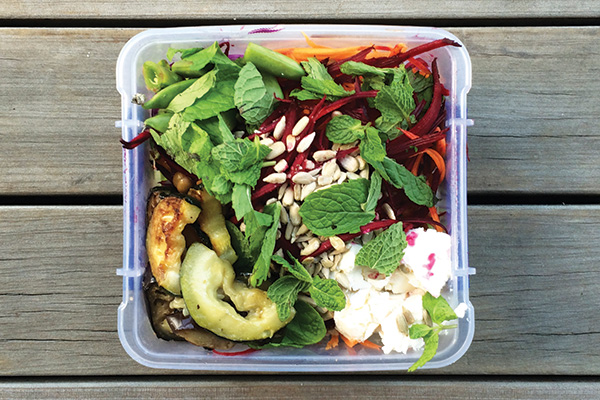Make the most of what remains of the salad vegetable season and compensate for the stodgy white-carb season that is approaching (#winteriscoming). The thing about salad is that most of the time the salads we all grew up with were dead boring, consisting of lettuce, tomato, cucumber and avocado — hardly Instagrammable, is it? So here are a few helpful tips and ingredient suggestions to help cram those vegetables into your poor, wilting student bodies.
Invest in a decent julienne peeler. Being able to serve up salads with your carrots ever-so-fashionably sliced into the thinnest strips will make your salad look right on trend. A decent Y-peeler also makes shredding cabbage and cucumber a dream and avoids the hassles of blunt, flat knives and chopping boards.
If adding roasted vegetables to your salad, then try roasting up a massive batch once or twice a week so that you can save time during the week. This also makes the idea of preparing your lunch salads less daunting.
Texture
I am a huge fan of mixing up the textures in my salad, whether that be from the crunch a handful of seeds provides or from the creamy mouthfeel of crumbled feta. Try incorporating vegetables with a bit more crunch than usual. I have been throwing in handfuls of sugar snap pods; not only are these crisp and refreshing, but they are super sweet as well. I love a sprinkling of sunflower or pumpkin seeds in my salad too. If you are feeling balla rich, then a handful of almonds works a treat too. I really like dollops of garlicky hummus as well. Not only does this lubricate the drier salad ingredients, but it also packs one hell of a flavour punch.Flavour
A handful of torn-up herbs makes a world of difference in your salad. For a traditional garden salad, try throwing in a few torn basil leaves. I am loving the oodles of mint leaves I have been putting in my Middle-Eastern inspired salads lately. You, of course, can’t go wrong with a handful of fresh coriander either. As mentioned earlier, try throwing spoonfuls of your favourite hummus or healthy dip onto your salad as well. Roasting cubes of vegetables and tossing them in garlic before putting them in the oven also gives your salad a kick in the pants. If you really feel like it, shake up a quick dressing to drizzle over the top.Eat Seasonally
Make the most of what is cheap at your vegie store or farmers’ market. Right now, aubergines and courgettes are in abundance. I love roasting chunks with a few cloves of crushed garlic and a drizzle of oil until they are soft. These lubricate the mouth, add garlicky flavour and go perfectly with mint. During the cooler months, root vegetables and pumpkins will be cheap as chips. These vegetables can also be turned into my favourite liquid salad known as soup, but I will delve into that topic in a later issue.Carbohydrates and Protein
Sometimes you want something a little more substantial than just leaves. Lately, I have been buying tins of brown lentils, draining them and throwing about a third of the can into each of my salads. They are a great source of protein, fibre and carbohydrate. I love to toss some rice vermicelli noodles through my salads to give them more of an Asian vibe. Drizzle over some sweet chilli and lime to add flavour, and your salad is transformed. During the wintertime, when root vegetables come into season, roasting up cubes of pumpkin, kumara and carrot is a great way to increase the satiating power of your salad bowl; try adding some walnuts and blue cheese to salads like these. Cheeses are a great source of protein, as are tins of tuna, leftover roast meats and eggs. Canned chicken, for those who have not tried it, is also delicious.A Note on Dressings
Dressings can easily be made from a few simple cupboard ingredients. Most of my favourite recipes contain non-perishable ingredients, so can just be kept in a jar in the fridge for many weeks. If packing your salad to-go, try keeping your dressing in a small container separate to the salad. You can buy small plastic vials from the supermarket. The acidity of dressings has a tendency to wilt your greens, making them less than appetising come lunchtime.Quick & Easy Dressing Ideas
Sweet Balsamic Dressing- 1/2 cup olive oil
- ¼ cup balsamic vinegar
- 3 teaspoons runny honey
- 2 teaspoons wholegrain mustard
Pomegranate Dressing
- 3 tablespoons pomegranate molasses (look in gourmet section at New World)
- 2 tablespoons balsamic dressing
- juice of 2 oranges
- ¼ cup olive oil
- 1 tablespoon honey
Lemon Dijon Dressing
- ½ cup olive oil
- juice of 1 lemon
- 2 teaspoons Dijon mustard
- 1 teaspoon sugar
- 2 cloves of garlic, minced
- ½ teaspoon salt
Here are some ideas for salad ingredients. Next time you go to a vegie shop, have a look around and ask yourself, can this go in a salad? More often than not, the answer is yes, so get creative!
Leaves
Iceberg lettuce, butter lettuce (smooth-edged, fancy lettuce), kale, baby spinach, rocket (gives a peppery flavour)
Colour
Shredded red cabbage, julienned carrot, tomatoes, cucumber, sliced radishes, julienned raw beetroot, sugar snaps, roast courgette, roast aubergine, red onion, avocado, watermelon, melon, stone fruits, oranges, blanched green beans and broccoli, capsicum (fresh or roasted)
Herbs
Fresh coriander, mint, basil, parsley
Crunch
Sunflower seeds, pumpkin seeds, nuts of your choosing, edamame beans (find them in the freezer of your local Asian supermarket)
Carbohydrates
Tinned lentils, roasted kumara, roast pumpkin, roast potatoes, cous cous, vermicelli rice noodles, homemade croutons, pita pockets, quinoa
Protein
Tinned fish, nuts, boiled eggs, cheeses, roast meats, tinned chicken
Flavour
Hummus, roasted vegetables, cheeses (feta, parmesan and blue vein are my picks), herbs, dressings, dried fruits, corn kernels



